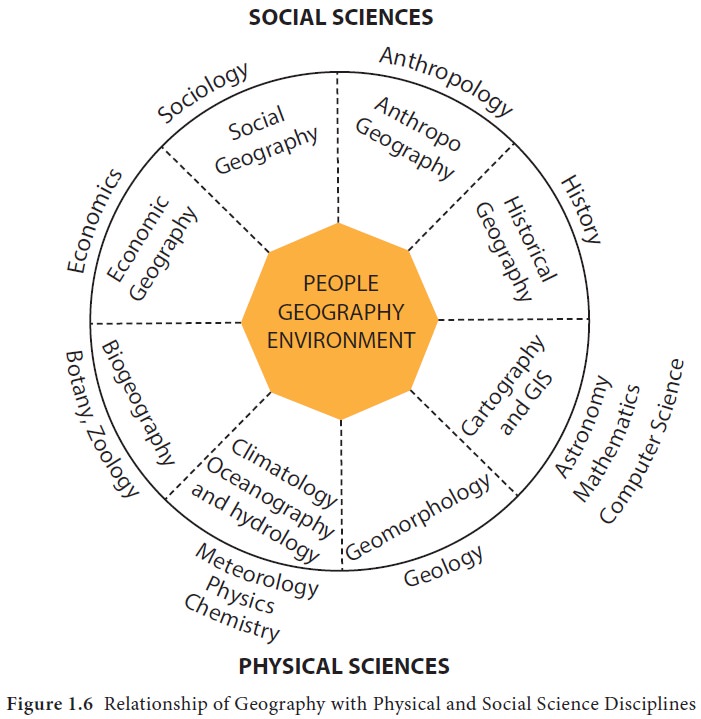Chapter: 11th Geography : Chapter 1 : Fundamentals of Geography
Geography's Relation with Physical and Social Science Disciplines
Geography’s
Relation with Physical and Social Science Disciplines
While defining geography, we have seen that some
branches of geography have strongest affiliations with subjects like
mathematics and environmental sciences, while others have very close connection
with history and sociology. Some subjects deal with distinctive type of
phenomena while geography examines several kinds of phenomena together. The
diagram (Figure 1.6) gives clear idea about the relationship of geography with
other disciplines.

Relations with Physical Sciences
Astronomy, Mathematics, Computer Science and Geography:
Astronomy basically deals with the celestial bodies
including stars, planets, satellites, their motions, constellations, as well as
different kinds of phenomena occurring in the outer space. The precise
location, nature of movements, form and size of celestial bodies, including
those of the solar system, have been accurately measured with the help of
mathematics. The interaction of astronomy, mathematics and computer science
with geography has paved way for the development of modern cartography and GIS.
Geology
and Geography:
Geology is the study of rocks, their types,
distribution, mineral content, petroleum, etc. The subject investigates all
these phenomena, classify them and put them in a sequence. Geography interacts
with the subject in studying the distribution of exposed rocks, interaction
with climate and human activities, economic prospects of the minerals and so
on. Interaction between geology and geography leads to formation of the new branch of study called geomorphology,
the study of landforms.
Physics,
Chemistry and Geography:
As geography is the study of variable phenomena on the earth’s surface, the dynamic mechanism of the phenomena requires to be studied within the framework of physics. The physics of atmosphere is studied under climatology and the physics of hydrosphere through oceanography, and both the subjects investigate, interpret and explain the atmospheric and hydrological processes. The chemical contents of rocks, soil, surface and groundwater, atmosphere are the interests of the geographers. They study how the physical and chemical contents are disturbed by human activities and vice versa.
Botany,
Zoology and Geography:
The systematic branches of botany and zoology have traditionally been confined to the classification and description of various kinds of species on the earth’s surface. Geography, being the study of the spatial section of earth’s surface, attempts to study the distributional aspects of flora and fauna especially with reference to climate and relief. The integration among these subjects has given birth to biogeography.
Relationship with Social Sciences
Economics
and Geography:
Economics is concerned with how human needs and
wants are satisfied with the available resources. Economic geography is
concerned with the study of resources endowment and patterns of utilisation.
The economic activities of the human beings including agriculture, fishing,
forestry, industries, trade and transport are studied in this branch. The
economic activities are highly influenced by the relief and climatic factors of
the region or the country. Therefore, economics and geography have close links
with each other, especially for integrated resources development.
Sociology
and Geography:
Sociology is mainly concerned with the
institutional aspects of the society. A number of investigations including
social behaviour, movement of people between rural-urban areas, spatial
interactions between social groups, the relations between innovation and
tradition in rural and urban areas etc., have been jointly undertaken by
sociologists and geographers in different countries of the world. Social
geography is the logical expression of the interaction between sociology and
geography as it studies social phenomena in spatial context.
Anthropology
and Geography:
Anthropology attempts to study human races and
their classification. Both anthropology and geography seek to identify and
classify the human races on the basis of their habitat and cultural traits and
attempt to study the variable racial phenomena on the spatial context of the
earth’s surface. The relationship between anthropology and geography has
resulted in the development of ‘anthropogeography’ or geography of humans.
History
and Geography:
History is a framework of events as per time and
place. Geography attempts to study these events with reference to the physical
earth and depict the places of historical events using thematic maps. Anyone
who attempts to study any historical events of India should always integrate
the temporal and the spatial phenomena of that period together to arrive at a
conclusion.
Tamil Rulers and Geographic Knowledge
History reveals to us that how the
Great rulers like Raja Raja Chola
or Rajendra Chola had trade relations with other countries of the world,
especially South Asian countries by understanding the relief, seasons, ocean
current movements etc., The sailors would have been experts in every aspect of
geography to move their troops, sail overseas and trade with all known nations
of that time. They also utilised the ocean currents to transport teak and other
valuable timbers from Indonesia, Myanmar, and other countries to South India.
Related Topics